Estimating prices
Why estimate prices at all?
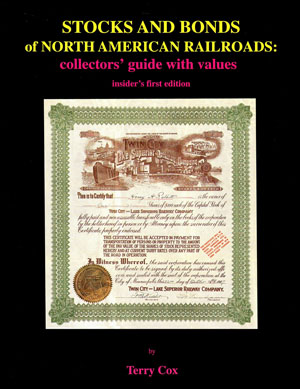
As explained elsewhere, I started this project to gather information about the prices that railroad certificates I was selling in the late 1980s. Once I divulged the project to the world after BNR Press published the first edition of my physical catalog in 1995, pricing remained the main concern of many of my readers, especially collectors new to the hobby.
Estimating the pricing of collectibles is a thankless job. Estimates NEVER satisfy everyone. A few catalogs about collectibles have been published without price estimates. This project would be DRAMATICALLY EASIER if I merely recorded varieties, However, I accept a critical fact about cataloging and it has kept me sane. No matter what price I estimate for any certificate in the project, buyers and sellers are going to disagree. It is the nature of the beast.
Once I embraced that concept, I realized that the effort that goes into pricing is NOT to make the greatest number of collectors and dealers happy. The was when I stumbled into the awareness of what I call the "Price Paradox."
The ideal price estimate is one where the greatest number of participants disagree with me.
Ideally, half of my readers should believe my estimates are too low and half should believe my estimates are too high. I am not aiming for an average price. I am not aiming for a median price. I am aiming for a price estimate that I feel is justifiable, reasonable, and fair.
"Please send more information"
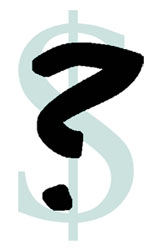
Like most seller, I hear this question a lot. Long experience with this question suggests that most collectors really do NOT want more information at all. Most simply want to learn what their certificates are "worth."
Only a few collectors contact me about certificates that retain values as securities. For them I have a special page on Security Values where I list the experts collectors should contact.
Except for the few certificates that retain security values, the rest are strictly collectibles made out of paper. They have no intrinsic value on their own. H‑O‑W‑E‑V‑E‑R , as long as certificates are in acceptably decent condition, they hold "collector value." That is the price upon which collectors and sellers might be able to agree.
In truth, my estimates are really just guesses. After all, I do not know precisely who wants to buy the next certificate, where they are buying, nor what their maximum purchase price is.
My guesses, however, are informed by records of the amounts other collectors have paid in the past. I may not know what collectors will actually pay during that short sliver of time when they and sellers agree, but I have records that show what they paid between 1980 and yesterday. To be realistic, I have no way of knowing every past sale because there are not enough hours in the day and dealers do not share their sales with anyone. Still, I try to have sufficient information to make educated guesses.
What markets are you participating in?
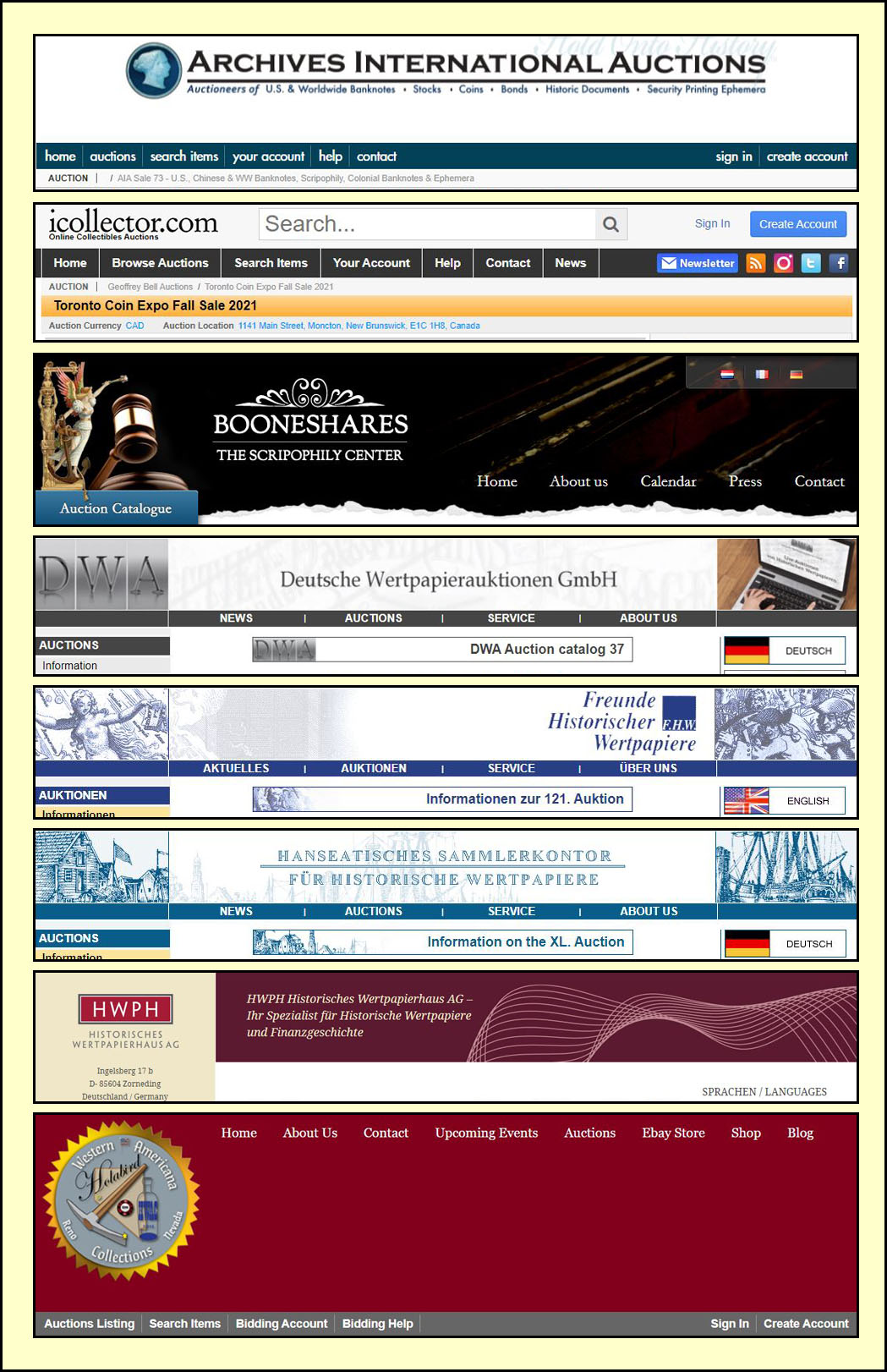
The online database shows ranges of estimated prices for almost all known varieties. Those are "list" prices I expect collectors will encounter when shopping with top-tier professional dealers in the United States. There is usually flexibility in "list" prices among professional dealers because they have large inventories and can improve prices for better customers and collectors who make large purchases. It is always advisable for collectors to make friends with professional dealers. After all, top-tier dealers and top-tier auction houses are the ones who offer top-tier certificates.
There are, of course, numerous "markets" and they all differ. Collectors generally migrate to the type of market that suits them best. Every market has different pricing characteristics and different types of certificates. I advise collectors to shop around and avoid locking themselves into single markets. Otherwise collections will "top out" and become static and dull.
Here are the major markets I track (organized alphabetically.)
- American auctions.
- American dealers (top-tier professionals.)
- American dealers (all others, some of whom specialize in restrcted industries.)
- Canadian auctions.
- German auctions and dealers (with similar sub-groups of generalists and specialists.)
- eBay (US, DE, UK.)
- European auctions and dealers outside Germany (also with sub-groups of generalists and specialists.)
- worldwide online auction platforms (Invaluable, Live Auction Group, iCollector.)
Typical price ranges
The hobby of scripophily is not populated by many collectors. It has greatly fewer participants than related hobbies like stamps, coins, and paper money. Although there are large numbers of varieties from which to assemble collections, the numbers of certificates for any particular variety are extremely low in comparison with those other hobbies. While there is very high rarity among a large number of varieties, there are very low numbers of collectors. Consequently, the prices paid for certificates are both low and highly variable. So variable, in fact, that I have noticed what I call a "typical 4x range in prices."
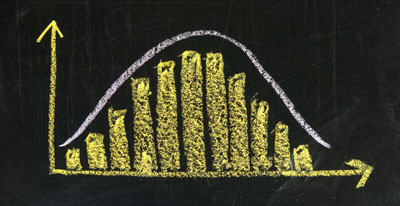
What I am defining in layman's language would be a verbal description of a statistical "bell curve" IF we had a sufficient number of prices to run such analyses. Even after tracking certificate sales for over thirty, years, most varieties have very few price records except among the most common. Within the remainder I commonly see prices range from 1x (the lowest price recorded) to 4x (the highest price.) For example, if the lowest price paid for a certificate of a certain variety were $25, it would be perfectly normal to see a purchase elsewhere or at a different time at $100.
To look at it another way, I might estimate a typical professional American dealer might offer a certificate of a specific variety and specific condition at $40. I fully expect to see examples of that exact variety sold on eBay for $20 and in a German auction for $80. There is large flexibility in pricing within identifiable markets, but especially across markets.
Price ranges can be much larger. For instance, in a single day in January, 2022, I recorded a common variety sell within a range of $2.63 to $25.99.

My "4x range" is not a hard and fast rule. Unrecognized rarities have been purchased at sub-wholesale prices on eBay (US) and re-sold in top-tier German auctions for much more than 4x. Conversely, "commodity-like" items such as selected certificates from the Baltimore & Ohio, Missouri Kansas & Texas, and Pennsylvania railroads can exhibit low price ranges because there are so many certificates available. Even among those kinds of items, price ranges of 2x to 3x are still common.
Beginner style collections
Please understand that every market displays wide spectrums of prices. Although a few professional dealers sell on eBay, that platform has the reputation for being the low-cost leader. Many beginners start their collections on eBay, but sooner or later run into limitations.
I catalog certificates from railroads and coal companies and notice that eBay tends to offer few certificates of intermediate rarity and almost no high-rarity certificates. Additionally, eBay works extremely hard at locking collectors into its platform. Major dealers and professional auction venues have limited ways of reaching beginners. Finally, collectors accustomed to wholesale-level eBay prices can suffer "sticker shock" when they first experience "real world" prices necessary to keep professional dealers and auction houses in business.
I stress that collectors who form "beginner collections" will always have "beginner collections" until they discover and interact with professional dealers and auction houses.
Since collectors visit this site to discover what their collections are "worth," I stress that "beginner collections" will never increase much in collectible value. In fact, their real-world values frequently drop when quantified in terms of dollar spending power. That does not mean collections of common certificates are not fun. That does not mean collections of common certificates cannot be attractive. But please understand that collections of "common" certificates frequently lose value relative to inflation. Thankfully, no one can remain in this hobby for more than a few years without acquiring a few rarities simply by accident.
Median price
My price records go back to 1980 and George LaBarre's 3-volume price guides: Collecting Stock and Bonds. A few additional price catalogs appeared in the mid-1980s, quickly accompanied by series of mail bid sales from LaBarre, Centennial Documents, and NASCA. The hobby really picked up steam with regular auctions of certificates after R.M. Smythe & Co. bought NASCA from Jules Karp in 1985.

Not every price collected since 1980 has relevance today, but many still do. Large numbers of certificates became more common after the break-up of a few large hoards. On the other hand, there was a noticeable run-up in prices in the late 1990s followed by reverses after the turn of the century. Many current prices remain similar to those of much earlier times.
When I enter sales results into the database and estimate any changes, I give greater influence to prices from recent sales. With every price entry, I compare new prices to a median calculated for each specific variety and condition I am entering. I do NOT use the median as my price estimate, but I use it to quickly learn where prices have been. (Prices from certificates in multi-item lots are ignored in calculating the median.) When a new price is seriously out of range with both median and pre-existing prices, I review additional information to learn longer-term price trends for that specific variety and where abnormal prices occurred. In extreme cases, I re-examine descriptions in auction catalogs and sales offerings to try to understand what might have caused oddly high or low prices.
How to price new discoveries?
It is more difficult to estimate prices for items that lack price histories. Actual sales prices are always the starting point for price estimation, but "first appearances" can be misleading. It is common to see "second appearance" prices higher than "firsts." The prices that certificates fetch on their second or third appearances typically end up being historical highs. I do not have any formal rules for estimating the prices of new discoveries, but generally speaking, there are repetitive types of new discoveries :
| Type of discovery |
Typical approach |
| variations on certificates already known in a specific company |
price identical to other certificates |
| stocks or bonds are new varieties and company is already populated by other varieties |
factor up or down from sale price depending on popularity of company, prices of other certificates, and where they previously sold |
| new discoveries are "other" certificates (not stocks or bonds) and company is already populated by different "other" certificates |
price similar to "other" pre-existing certificates |
| new certificate type in existing company |
factor up or down from sale price depending on rarity of company, prices of other certificates from that company and where sold |
| completely new company |
factor up or down from sale price depending on popularity of state of incorporation and where sold |
| new vignetted certificates |
premium on sale price depending on where sold |
| non-vignetted certificates |
flat or slightly lower sale price depending on where sold |
| unusual colors |
measurable premium on sale price depending on where sold |
| intaglio printed by major company (American Bank Note Co, National Bank Note or Homer Lee, et al.) |
slight to measurable premium on sale price depending on where sold |
| graded certificates |
flat to significant penalty on sale price |
| unissued remainders |
flat to penalty on sale price depending on where sold |
| #1 serials and high denominations |
premiums to large premium on sale price factored by where sold |
What about new or rare items that do not sell?
This is a tough question. This situation happens frequently, especially with items offered in auctions. One of the problems for auction sellers is trying to gauge the mood of collectors one to several months in the future. That problem is magnified when auctioneers need to produce and mail physical catalogs. If auctioneers have live bidders present at their auction venues, they can adjust minimum or starting bids to promote bidding. It is extremely common for auctioneers at live events to find no bidders at initial opening bid prices. Often, they will lower opening amounts, maybe more than once, in order to get bidding started. Once bidding starts, competitors enter the fray and it is quite common to see items sell for more than the original failed opening amount. Mail and online-only auctions do not have the luxury of lowering starting bid amount; their only choice is to re-offer in a future auction.
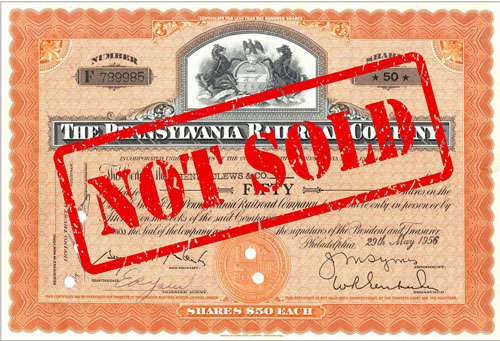
Fixed-price websites are often plagued by not knowing where the market is for rare and unusual items. Should prices be lower? Or higher? How long should a seller wait before re-pricing?
Another issue sellers wrestle with is trying to gauge how many "eyeballs" might be looking at their offerings. If an auctioneer is sending out physical catalogs, one can reason that most recipients are at least paging through catalogs if for no other reason than looking at pretty pictures. Whether they bid or not can be measured after the sale. That answer, of course, creates a new question: How long should an auction company send expensive catalogs to non-bidders? Fixed-price websites can measure overall traffic by Google Analytics, but there is usually no way of knowing how many collectors are viewing any single item. Even if a certificate sells, questions remain about whether the buyer was the first to view the item, or the fiftieth.
The numbers of "eyeballs" is a universal issue with both fixed-price websites and auction. Even eBay auctions! If rare and unusual items remain unsold after several auctions or several months, the problem becomes mine. I need to decide whether all those earlier offer prices were even reasonable.
I usually like to keep my price estimates at or a slightly above dealer "ask prices" for rarities. For auctions, I factor in the added cost of buyer's commissions, including value-added taxes when applicable. If I see the same items go unsold for a year or more on websites or unsold after three or four auction appearances, I must conclude that prices are higher than buyers and bidders are willing to pay. Either that or the seller needs to attract more eyeballs.
In that situation, I adjust prices according to my experience. Sometimes I lower prices. Sometimes I raise prices when I suspect different dealers might be able to sell certificates at higher prices. (In other words, I am applying an "eyeballs" factor.)
An item might be wanted, but not terribly desirable
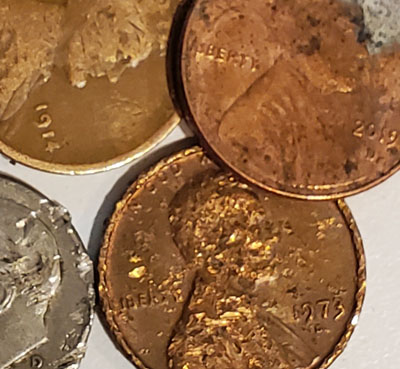
Estimating values of collectible certificates involves trying to quantify how various features of certificates might affect desirability. Desirability is a highly complex interplay of features that causes collectors to want certain items and ignore others.
I have spent years trying to understand how various features affect pricing. I intend no cynicism when I suggest that the single most important variable is commonly the amount of available money or the amount a buyer wants to spend at a particular time.
There are, of course, many other things that affect how much collectors might be willing to pay for certificates. Here are some of the observations I have made:
- Age – Collectors usually pay more for older certificates regardless of rarity.
- Autographs – Signatures of important celebrities enhance values more than all other features combined. Autographs from insignificant individuals do not affect prices at all.
- Back designs – Collectors occasionally offer a little more for certificates with colored or engraved backs but sellers rarely convey that fact.
- Cancellation – Collectors normally pay more for uncancelled certificates than cancelled ones. Lightly-cancelled certificates usually attract higher prices than heavily cancelled versions.
- Certificate types – Stocks and bonds usually attract higher bids than other types of certificates of similar or greater rarity such as certificates of deposit, subscription receipts, temporary certificates, and so forth.
- Collections – Collectors and dealers absolutely do NOT pay higher prices for "complete" collections. Sellers who insist on selling whole collections intact are not doing themselves any favors.
- Company names – Certificates from certain popular companies and their predecessors (Rock Island, Santa Fe, for instance) often attract premiums over certificates of equal rarity from other companies.
- Condition – Collectors normally pay a little more for certificates in good condition. Folds and punch holes are normal. Collectible certificates are often so scarce that collectors ignore minor problems.
- Corporate history – Collectors usually pay a little more for certificates from companies of historical significance.
- Denominations – Collectors often pay more for stock certificates that represent high percentages of companies' worth. Collectors also pay more for high-denomination bonds.
- Engraved certificates – Collectors pay more for certificates with custom-engraved vignettes than plain or generic certificates.
- Framed certificates – Inexperienced collectors often pay more for framed certificates; experienced collectors usually pay significantly less. Framed certificates are often sun-damaged and framing normally prevents collectors from properly examining certificates prior to purchase.
- Generic certificates - European collectors commonly pay more and North American collectors generally pay significantly less for certificates with generic designs, even though the certificates themselves may be scarce or rare.
- Handwritten certificates or company names – Price histories suggest few collectors are drawn to these items, regardless of rarity.
- Imprinted revenue stamps – Collectors commonly pay small premiums for railroad certificates with imprinted United States revenue stamps, but premiums have been dropping for many years. They appear to ignore imprinted revenues from other countries.
- Issuance – Collectors pay more for issued certificates than they do for unissued remainders. This general rule is highly confused on eBay.
- Location – Most people collect certificates from locations that hold personal interest. Locations are often more important to most collectors than any feature other than autographs.
- Multi-item lots – Collectors do NOT pay fair prices for all items in multi-item (two or more) lots. If two items are being offered, buyers usually pay for one. The more items offered, the greater the penalty on per-item price.
- Operating companies – Collectors often pay more for certificates from companies that actually operated than for companies that existed only "on paper."
- Printing companies – Collectors usually pay more for certificates from American Bank Note Company than those of equal rarity or appearance from other companies.
- Proofs and specimens – Depending on the type of proof involved, proofs can be either cheaper or more expensive than regular certificates; collectors have paid amount the same amounts for issued certificates and specimens in recent years.
- Rarity – Rare certificates are usually more valuable than common certificates. Contrary to prevailing myth, rarity among certificates does not always increase price.
- Serial numbers – European collectors generally pay 50% to 100% more for certificates with #1 serial numbers. Certificates with #2 and #3 serial numbers occasionally show some enhanced value; serial numbers #4 and above rarely increase prices. American collectors generally ascribe lesser value to low serial numbers.
- Themes – Vignettes with certain identifiable themes (Niagara Falls, autos, oil wells, famous people) occasionally attract higher prices than those with normal rail- and coal-related engravings.
Exceptions to EVERY rule
There are NO hard and fast rules for price estimation. Certain features are usually more important than others, but not always. This unpredictability frequently causes very strange price behavior. It is extremely common to see nearly-identical certificates sell for $25 one month, $50 the next and $13 the month after. It is not uncommon to see even larger price ranges!